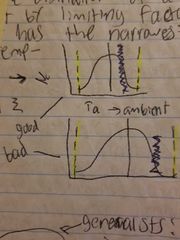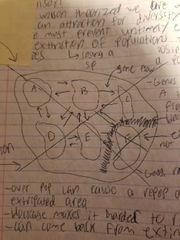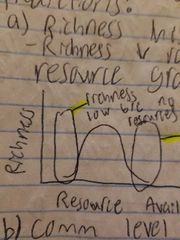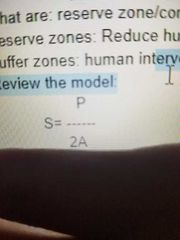![]()
![]()
![]()
Use LEFT and RIGHT arrow keys to navigate between flashcards;
Use UP and DOWN arrow keys to flip the card;
H to show hint;
A reads text to speech;
82 Cards in this Set
- Front
- Back
|
For threats to bio diversity and richness |
Habitat loss/degradation Climate change IAS Over harvest |
|
|
3 goals of conservation biology |
Document full range of bio diversity Investigate human impacts Develop practical approaches |
|
|
Ecological foot print |
Land and water needed to supply humans with needed resources to survive and a place to deposit waste |
|
|
Endocrine disruptor |
Materials released via industrial processes that interfere with normal endocrine functions |
|
|
Evolution |
Change in gene frequency with in a population over time |
|
|
How does a gene frequency change |
Natural selection Mutation Gene flow Genetic drift |
|
|
How do populations change in size |
Mortality Natality Immigration Emigration |
|
|
How many extent species |
1.8 million |
|
|
Biophilia |
EO Wilson says we're wired to be attracted to diversity |
|
|
Extinction |
Losing a species |
|
|
Extirpation |
Losing a pop |
|
|
Symbiosis |
Interaction between 2 or more species living in close proximity |
|
|
4 categories of ecosystem services |
Provisioning - food and water Regulating - climate and disease Cultural - tourism in religion Supporting - ecosystem functions |
|
|
Eco system |
Bio system where biotic communities interact with abiotic conditions |
|
|
Community |
Group a population of differing species interacting in the same place at the same time |
|
|
Resistance |
Ability of a system to maintain a steady state and the face of a chronic stressor |
|
|
Resilience |
Ability of a system to return to original state after chronic stressor |
|
|
Biological species |
In a group of interbreeding individuals that are productively isolated from other groups and re productively viable |
|
|
Morphological species |
A group of morphologically similar individuals |
|
|
Shelford's law |
Distribution of a species for be set by limiting factors to which it has the narrowest range |
|
|
Shelford's law on atm temp |

As atm temp moves toward limiting factors, pop will decline |
|
|
Top down disturbance |
Removal of predator causes increase of another species population, typically what the prey was |
|
|
Bottom up disturbance |
Remove all of primary producers Alters energy availability and impacts higher trophic levels |
|
|
Draw Meta population |

|
|
|
Dominant species |
Large biomass large impact |
|
|
Keystone species |
High impact low biomass |
|
|
Rare species |
Little biomass low impact |
|
|
Common species |
High biomass low impact |
|
|
Umbrella species |
Species that need particular resources or large tracks of pristine habitat. If their needs are met other species will follow |
|
|
Driver species |
Tend to be responsible for community structure/function |
|
|
Passenger species |
Species who are replaceable |
|
|
Alpha richness |
Number of species that exist at the study site Calculated as the average Driven by complexity and highest at low latitudes |
|
|
Beta richness |
Link between alpha and gamma Calculated by gamma/alpha Represents change of richness as you move along a Cline |
|
|
Gamma richness |
Number of all species and all habitats of a region Calculated by the number of unique individuals in all habitats |
|
|
Rapaport's rule |
As latitude increases range size increaes But richness decreases |
|
|
10% rule with food webs |
As trophic level increases only 10% of the energy |
|
|
Diversity |
Combination of richness and even. Weight of the species with some value |
|
|
Richness |
Number of species in the study area |
|
|
Heterozygosity |
Percent of jeans where the average individual is heterozygous |
|
|
Polymorphic genes |
Genes with more than one allele |
|
|
Allele |
Variant copies of a gene |
|
|
Inbreeding depression |
INCREASES Offspring death and physical impairment DECREASES Natality of inbred offspring, pred avoidance and mating efficiency |
|
|
Modified Fisher's Theorem |
In any given population of sexually reproductive individuals, the rate of evolutionary change is directly proportional to the amount of genetic variability present in a population |
|
|
Dynamic equilibrium theorem |
Emphasis on interaction between disturbance and productivity and how it impacts richness High prod, low disturb=LOW rich High prod, high disturb=HIGH rich Low prod, high disturb=LOW rich Low prod, low disturb=HIGH rich |
|
|
Paradox of enrichment |

The addition of limiting nutrients can falter richness |
|
|
Tropical conservatism hypo |
Higher latitudes are colder in younger they have lacked the time to accumulate species |
|
|
Intrinsic factors |
Life history, Physiological, anatomical, and behavior quirks Amphibians with thin skin example |
|
|
Extrinsic factors |
Abiotic and biotic factors Hab deg/loss |
|
|
Habitat deg VS loss |
DEG: impact on many, but not all sp Usually not complete loss, recovery is possible LOSS: impact on nearly all sp Initial impact rapid, recovery is iffy |
|
|
Habitat fragmentation |
Breaking up of continuous habitats into smaller invariably spaced habitat islands |
|
|
Why is frag a prob if H' is good? |
Natural fragmentation has seamless transitions and high internal structure Man made frag have simplified patches and matrix issues |
|
|
Frag steps |
Perforation- gaps form Gap extension- gaps grow larger and more numerous Gap coalescence- gaps join together |
|
|
Ecotone |
Transition between biomes |
|
|
Ecol trap |
High preference, low quality, leads to a sink Typically altered |
|
|
Perceptual trap |
Low pref, high quality, increases fitness |
|
|
Source pop v sink |
HIGHER Pop Survival Bby production Emigration Preference Quality LOW Demo flux SINK IS OPPOSITE |
|
|
Edge effects |
Outer Banbury's of a fragment that are not aligned but rather a zone of influence |
|
|
Range size |
Where species occur |
|
|
Habitat specificity |
Empirically verify |
|
|
Pop size |
Demographic trends |
|
|
Minimum viable population |
Population size for a specie or population has a reasonable probability of surviving a given time period |
|
|
PVAs are for |
Threatened or endangered sp |
|
|
Minimum dynamic area |
MVPs are housed here Calculated by range size and behavior |
|
|
Demographic stochasticity |
Fluxes in pop |
|
|
Genetic drift |
Random loss of genetic diversity |
|
|
Environmental stochasticity |
Enviro fluxes may impact MINE |
|
|
Genetic stochasticity |
Loss of genetic variability |
|
|
Phenotypic plasticity |
Specific genotype works across a range of enviro conditions |
|
|
Extinction vortex |
Interaction of pop size H' predicts future survival Inbreeding depression and GD issues |
|
|
IAS |
Species that are spread outside of historic/current ranges |
|
|
3 steps of invasion |
Introduction Established Pes |
|
|
Tens rule |
Only 10% of IAS outside of captivity will move on to the next step |
|
|
Integrated pest management |
Using multiple control methods |
|
|
Allee effects |
When I population shrinks to a low number we may observe a number of issues with populations stability |
|
|
Competitive exclusion |
No 2 species can occupy the same niche at the same time at the same place |
|
|
Ways to make reserves more efficient |
Complete protection Larger and more reserves Focus on more H' Avoid irregular shapes Establish zones Manage regionally not locally |
|
|
Conservation unit |
Species ecosystem or physical structures |
|
|
The 3 R's |
Representation: preserve as many CUs as possible Resilience: large, well protected CUs Redundancy: multiple examples same CU |
|
|
Reserve zones |
Reduce human impact |
|
|
Buffer zone |
Managed human intervention |
|

|
S=1 means more circular shape |
|
|
Principles use to develop reserve |
Comprehensiveness Representativeness Adequacy Efficiency Flexibility Irreplaceability Connectivity |

